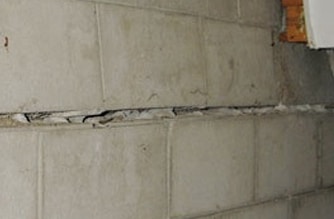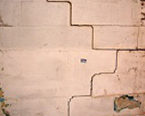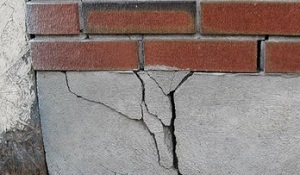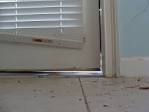So you’ve got a crack in your wall or floor, and you want to know whether or not it is serious. As a general rule of thumb, signs of a serious crack include those that are horizontal, wide, deep or continue to separate. The best way to know whether a crack could indicate a potential problem in your basement or foundation is to analyze it carefully and ask yourself these six basic questions:
 Within a year or so after any structure is built, the foundation settles into the soil beneath it. This often results in minor vertical cracks in the foundation or interior walls. Unless there were problems in how the building was designed or constructed, these cracks are usually no cause for concern. They can be repaired easily by applying putty to the crack, sanding it even with the wall, and painting over it.
Within a year or so after any structure is built, the foundation settles into the soil beneath it. This often results in minor vertical cracks in the foundation or interior walls. Unless there were problems in how the building was designed or constructed, these cracks are usually no cause for concern. They can be repaired easily by applying putty to the crack, sanding it even with the wall, and painting over it.
 The first question to ask is whether the crack is horizontal, vertical, or diagonal. If the crack is vertical and starts at the ceiling, it is likely to be a settlement crack. If the crack is horizontal or diagonal, running at a 45° angle, it might be an indication of water damage or a shift in the foundation. Such cracks usually require professional help to determine the exact cause and the best solution for repair to prevent further damage.
The first question to ask is whether the crack is horizontal, vertical, or diagonal. If the crack is vertical and starts at the ceiling, it is likely to be a settlement crack. If the crack is horizontal or diagonal, running at a 45° angle, it might be an indication of water damage or a shift in the foundation. Such cracks usually require professional help to determine the exact cause and the best solution for repair to prevent further damage.
 A stair-step crack looks similar to a flight of stairs and runs in both vertical and horizontal directions. It is usually seen in unfinished basements where the crack follows the grout or cement lines between cinder blocks. Usually, they are a result of soil settling beneath the foundation walls. The only way to be certain if the issue is serious is to hire an engineer to test the soils for signs of moisture or continued sinking.
A stair-step crack looks similar to a flight of stairs and runs in both vertical and horizontal directions. It is usually seen in unfinished basements where the crack follows the grout or cement lines between cinder blocks. Usually, they are a result of soil settling beneath the foundation walls. The only way to be certain if the issue is serious is to hire an engineer to test the soils for signs of moisture or continued sinking.
Another sign of a potential problem is  if a vertical crack is wider at the top than the bottom or if any crack continues to become wider than a dime. This indicates that the crack is changing and could lead to water leakage or eventual foundation failure. A crack that gradually begins to leak also indicates that it has become deeper and should be addressed before you have major water issues.
if a vertical crack is wider at the top than the bottom or if any crack continues to become wider than a dime. This indicates that the crack is changing and could lead to water leakage or eventual foundation failure. A crack that gradually begins to leak also indicates that it has become deeper and should be addressed before you have major water issues.
 A simple way to test a crack is to open and close doors and windows to see if they stick. If they are not sticky due to paint, loose hardware, or cracked frame, this might indicate a moderate or severe shift in the foundation which requires attention. If you notice a gap or light shining through gaps in the door or window, that might also indicate a serious settlement problem. You should call a foundation professional to check it out.
A simple way to test a crack is to open and close doors and windows to see if they stick. If they are not sticky due to paint, loose hardware, or cracked frame, this might indicate a moderate or severe shift in the foundation which requires attention. If you notice a gap or light shining through gaps in the door or window, that might also indicate a serious settlement problem. You should call a foundation professional to check it out.
At Pro Foundation Technology, we are experts at evaluating cracks in your walls, floors, and foundation and will provide you with a cost-effective solution through either basement waterproofing, concrete leveling or foundation repair. We use only the best-quality Earth Contact Products (ECP) and are the recognized expert in water management and foundation repair in Kansas City and nearby communities in Kansas and Missouri. Contact us today!